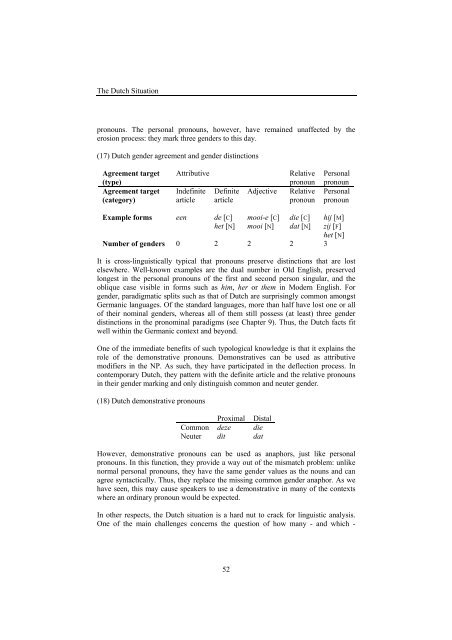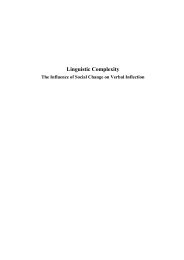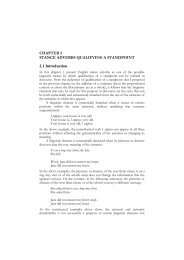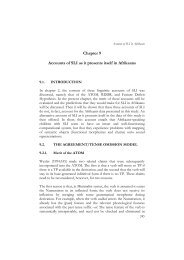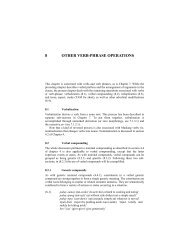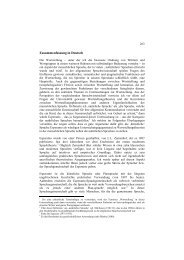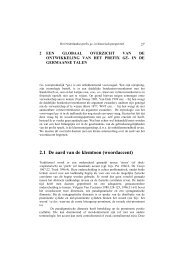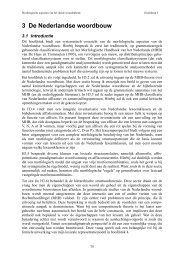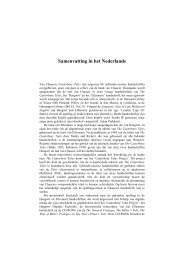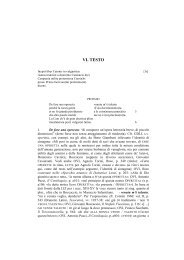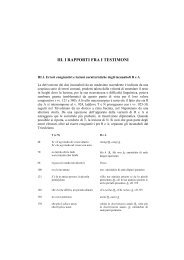Chapter 3 The Dutch Situation - LOT publications
Chapter 3 The Dutch Situation - LOT publications
Chapter 3 The Dutch Situation - LOT publications
Create successful ePaper yourself
Turn your PDF publications into a flip-book with our unique Google optimized e-Paper software.
<strong>The</strong> <strong>Dutch</strong> <strong>Situation</strong><br />
pronouns. <strong>The</strong> personal pronouns, however, have remained unaffected by the<br />
erosion process: they mark three genders to this day.<br />
(17) <strong>Dutch</strong> gender agreement and gender distinctions<br />
Agreement target<br />
(type)<br />
Agreement target<br />
(category)<br />
Example forms een de [C]<br />
het [N]<br />
Attributive Relative<br />
pronoun<br />
Indefinite Definite Adjective Relative<br />
article article<br />
pronoun<br />
52<br />
mooi-e [C]<br />
mooi [N]<br />
die [C]<br />
dat [N]<br />
Number of genders 0 2 2 2 3<br />
Personal<br />
pronoun<br />
Personal<br />
pronoun<br />
hij [M]<br />
zij [F]<br />
het [N]<br />
It is cross-linguistically typical that pronouns preserve distinctions that are lost<br />
elsewhere. Well-known examples are the dual number in Old English, preserved<br />
longest in the personal pronouns of the first and second person singular, and the<br />
oblique case visible in forms such as him, her or them in Modern English. For<br />
gender, paradigmatic splits such as that of <strong>Dutch</strong> are surprisingly common amongst<br />
Germanic languages. Of the standard languages, more than half have lost one or all<br />
of their nominal genders, whereas all of them still possess (at least) three gender<br />
distinctions in the pronominal paradigms (see <strong>Chapter</strong> 9). Thus, the <strong>Dutch</strong> facts fit<br />
well within the Germanic context and beyond.<br />
One of the immediate benefits of such typological knowledge is that it explains the<br />
role of the demonstrative pronouns. Demonstratives can be used as attributive<br />
modifiers in the NP. As such, they have participated in the deflection process. In<br />
contemporary <strong>Dutch</strong>, they pattern with the definite article and the relative pronouns<br />
in their gender marking and only distinguish common and neuter gender.<br />
(18) <strong>Dutch</strong> demonstrative pronouns<br />
Proximal Distal<br />
Common deze die<br />
Neuter dit dat<br />
However, demonstrative pronouns can be used as anaphors, just like personal<br />
pronouns. In this function, they provide a way out of the mismatch problem: unlike<br />
normal personal pronouns, they have the same gender values as the nouns and can<br />
agree syntactically. Thus, they replace the missing common gender anaphor. As we<br />
have seen, this may cause speakers to use a demonstrative in many of the contexts<br />
where an ordinary pronoun would be expected.<br />
In other respects, the <strong>Dutch</strong> situation is a hard nut to crack for linguistic analysis.<br />
One of the main challenges concerns the question of how many - and which -


